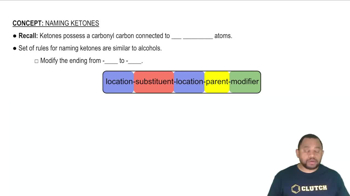Here are the essential concepts you must grasp in order to answer the question correctly.
Aldehydes
Aldehydes are organic compounds characterized by the presence of a carbonyl group (C=O) at the end of a carbon chain. The general formula for aldehydes is RCHO, where R represents a hydrocarbon group. Common examples include formaldehyde (HCHO) and acetaldehyde (CH3CHO). Naming aldehydes involves identifying the longest carbon chain containing the carbonyl group and using the suffix '-al'.
Recommended video:
Rules for Naming Aldehydes
Ketones
Ketones are organic compounds that contain a carbonyl group (C=O) located within a carbon chain, rather than at the end. The general formula for ketones is RC(=O)R', where R and R' are hydrocarbon groups. Common examples include acetone (CH3COCH3) and butanone (C4H8O). Ketones are named by identifying the longest carbon chain that includes the carbonyl group and using the suffix '-one'.
Recommended video:
Nomenclature of Organic Compounds
The nomenclature of organic compounds follows specific rules set by the International Union of Pure and Applied Chemistry (IUPAC). This system provides a standardized way to name compounds based on their structure, functional groups, and the length of the carbon chain. For aldehydes and ketones, the position of the carbonyl group and the presence of other functional groups are crucial for determining the correct name and ensuring clarity in communication among chemists.
Recommended video:
Introduction to Organic Chemistry
 Verified step by step guidance
Verified step by step guidance


